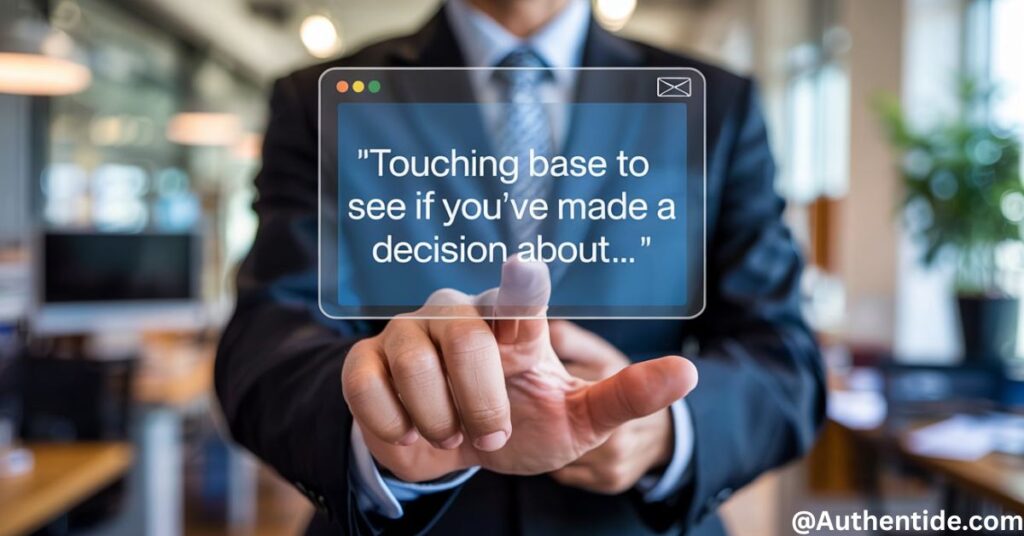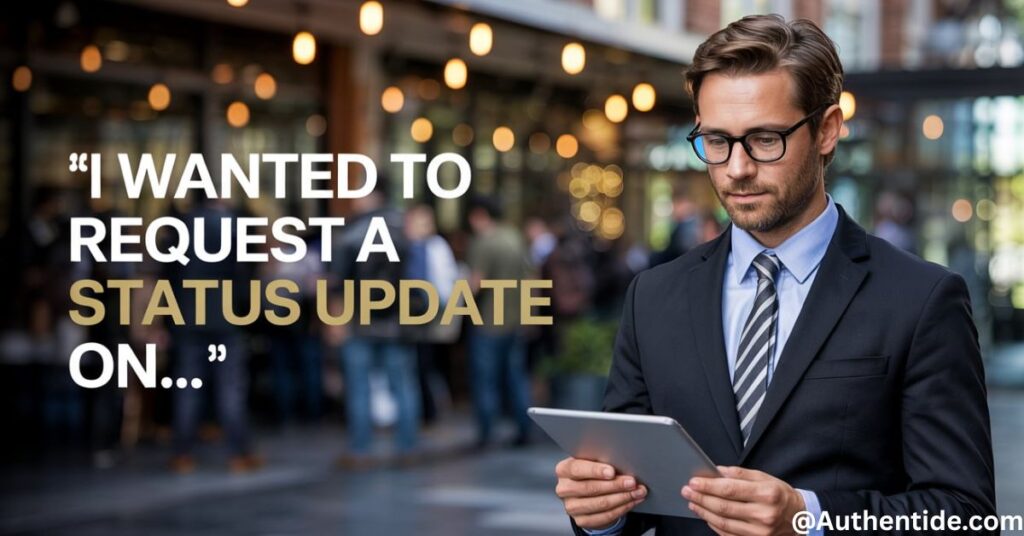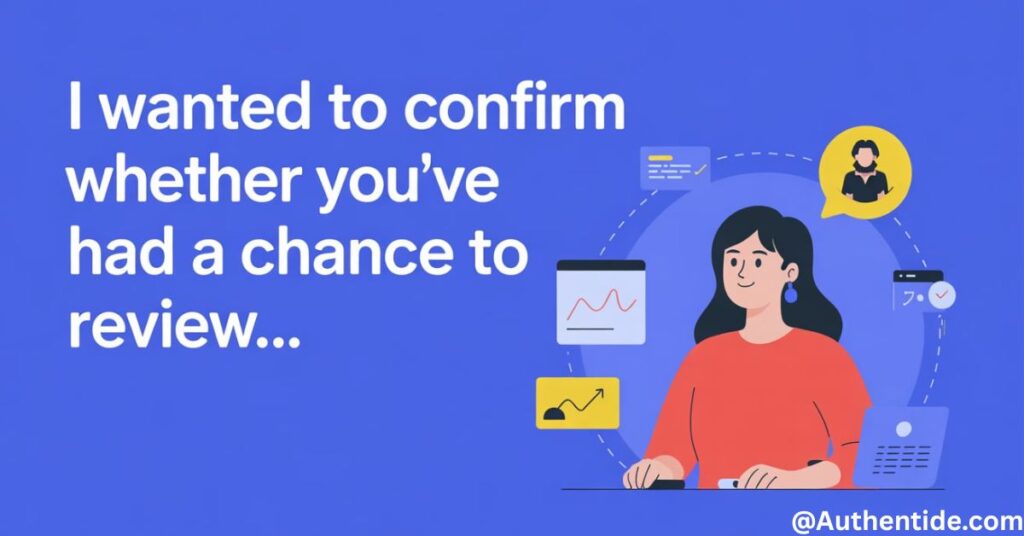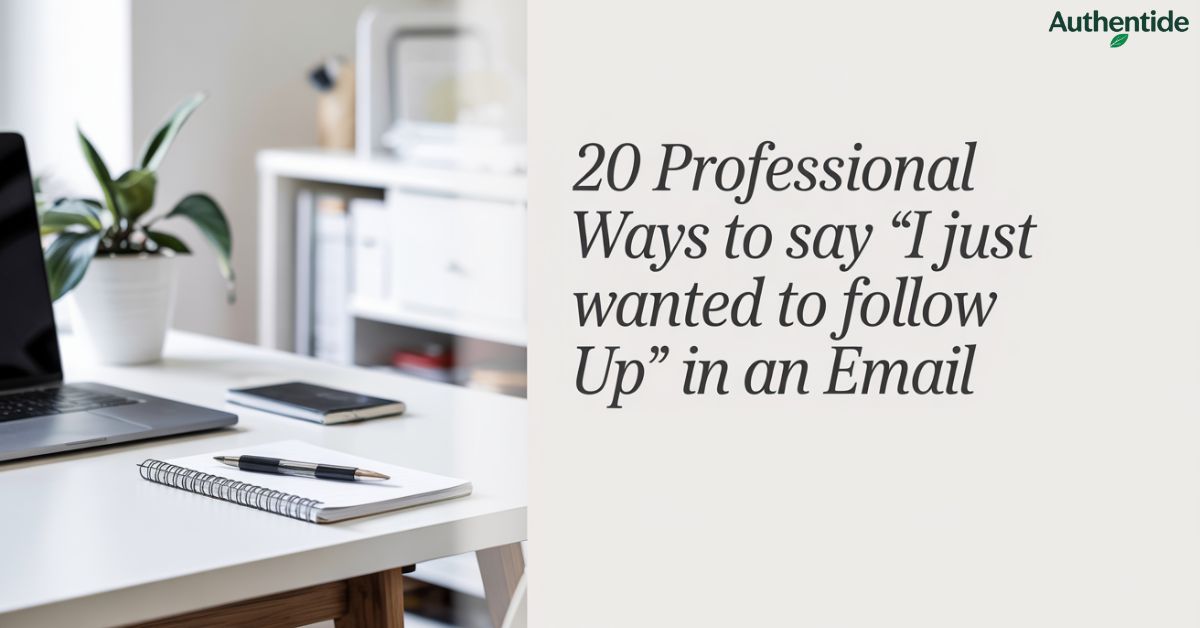Follow-up emails represent a critical touchpoint in professional communication, often determining whether your previous message gains traction or fades into inbox obscurity. Crafting the perfect follow-up requires balancing persistence with respect pushing just enough to stay on someone’s radar without crossing into annoyance territory. Many professionals default to the standard “I just wanted to follow up” phrase, unaware that this overused opener might actually diminish their message’s impact.
By expanding your follow-up vocabulary and tailoring your approach to specific situations, you can significantly increase response rates while maintaining positive professional relationships. The difference between a forgotten email and action-driving correspondence often lies in those crucial opening lines.
What to Say Instead of “I Just Wanted to Follow Up”
- “Touching base on our previous conversation”
- “Following up on our discussion regarding…”
- “Checking in on the status of…”
- “I wanted to circle back about…”
- “Reaching out for an update on…”
- “I’m following up to inquire about…”
- “Just checking to see where we stand on…”
- “I wanted to see where we are with…”
- “Checking whether there’s been any progress on…”
- “I’m curious if you’ve had a chance to…”
- “Kindly requesting an update regarding…”
- “Touching base to see if you’ve made a decision about…”
- “I wanted to follow up on our previous email exchange regarding…”
- “I’m writing to check if there’s any update on…”
- “As discussed, I’m following up about…”
- “I wanted to request a status update on…”
- “Circling back on our conversation about…”
- “Following up on my previous message regarding…”
- “I’m checking back about our discussion on…”
- “I wanted to confirm whether you’ve had a chance to review…”
Is It Professional to Say “I Just Wanted to Follow Up”?
Saying “I just wanted to follow up” isn’t inherently unprofessional, but it comes with limitations. This phrase has become so common in business communication that it risks blending into the background noise of a busy inbox. The word “just” can also subtly undermine your message by suggesting your inquiry isn’t particularly important.
The effectiveness of your follow-up often depends on context and relationship. With close colleagues, this casual phrasing might work fine. However, when communicating with executives, clients, or new contacts, more thoughtful alternatives can significantly improve your response rates and perception.
What truly makes a follow-up professional isn’t necessarily avoiding this phrase entirely, but ensuring your message adds value, respects the recipient’s time, and maintains a clear purpose. The best email communication acknowledges the recipient’s busy schedule while confidently stating what you need.
20 Better Ways to Say “I Just Wanted to Follow Up” in an Email
Here are 20 Better Ways to Say “I Just Wanted to Follow Up” in an Email:
1. “Touching base on our previous conversation”

This professional alternative feels more purposeful than “just following up” because it explicitly references your history together.
Scenario Example:
Subject: Project Timeline - Touching Base
Hi Marcus,
I'm touching base on our previous conversation about the Q3 marketing timeline. During our meeting last week, you mentioned having updated projections by today. I'm eager to incorporate those numbers into our presentation for Friday's executive review.
Would you be able to share those updates by end of day tomorrow?
Thanks,
Danielle
This approach works well when you’ve had a clear agreement about next steps and deadlines. It gently reminds the recipient of their commitment without sounding accusatory.
2. “Following up on our discussion regarding…”
This phrase maintains professionalism while being direct about what you need. The specific reference helps jog the recipient’s memory immediately.
Scenario Example:
Subject: Following up on website redesign proposal
Hi Priya,
I'm following up on our discussion regarding the website redesign proposal I sent on March 12th. Your team mentioned expecting to make a decision by the end of the month, which is approaching soon.
Has your committee had a chance to review the materials? I'm happy to address any questions or provide additional information to support your decision-making process.
Best regards,
Julian
3. “Checking in on the status of…”
This phrasing shows respect for the person’s process while still requesting information. It acknowledges that work is likely happening on their end.
Scenario Example:
Subject: Checking in - Invoice #8742
Hello Tariq,
I'm checking in on the status of invoice #8742, which was submitted three weeks ago. Our records show the payment was due yesterday.
Has your finance department processed this payment? If there are any issues or documents needed from our side, I'd be happy to help resolve them promptly.
Thanks for your assistance,
Leila
4. “I wanted to circle back about…”
This casual yet professional phrase feels less demanding than a direct follow-up while still clearly communicating your intent.
Scenario Example:
Subject: Circling back - Team lunch options
Hi Team,
I wanted to circle back about our department lunch scheduled for next Friday. Several options were proposed in my previous email, but we haven't reached a consensus yet.
To ensure we can secure a reservation, could everyone please vote on their preference using the quick poll below by tomorrow afternoon?
Looking forward to this team celebration!
Carlos
5. “Reaching out for an update on…”
This phrasing positions your message as a request for information rather than pushing for action, which often feels less pressuring to the recipient.
Scenario Example:
Subject: Update Request - Client Presentation Materials
Hello Andrea,
I'm reaching out for an update on the client presentation materials we discussed last Thursday. As mentioned, we'll need these finalized by this Friday to allow time for executive review before next week's meeting.
How are those materials progressing? Is there anything you need from my team to help complete them on schedule?
Thanks,
Robert
6. “I’m following up to inquire about…”

This formal variation works well in situations requiring more professional distance, such as communications with senior management or important clients.
Scenario Example:
Subject: Inquiry - Annual Budget Approval
Dear Dr. Thompson,
I'm following up to inquire about the status of our department's annual budget approval. The proposal was submitted to your office on February 3rd, and we're eager to begin implementing our Q2 initiatives.
Could you provide an estimated timeline for when we might expect a decision? This information would greatly help our planning process.
Respectfully,
Sophia Chen
Budget Director
7. “Just checking to see where we stand on…”
This conversational approach works well with colleagues you have a comfortable relationship with, striking a balance between casual and professional.
Scenario Example:
Subject: Conference Room Booking Status?
Hey Alex,
Just checking to see where we stand on booking the main conference room for next month's client workshop. You mentioned you'd speak with facilities about reserving it for the full day.
Should I start exploring backup venues, or were you able to secure the space?
Thanks!
Miguel
8. “I wanted to see where we are with…”
This collaborative phrasing suggests you’re working together toward a common goal rather than simply waiting for something from them.
Scenario Example:
Subject: Contract Review Process
Hi Tara,
I wanted to see where we are with the contract review process for the Miller project. Our timeline indicates we should be nearing the final approval stage.
Has legal completed their review? Is there anything from our end that could help move this forward to meet our target implementation date?
Best,
Noah
9. “Checking whether there’s been any progress on…”
This approach acknowledges that processes take time while still emphasizing the need for movement forward.
Scenario Example:
Subject: Progress Check - Software License Renewal
Hello IT Support Team,
I'm checking whether there's been any progress on our software license renewal request (Ticket #45872) submitted two weeks ago. Our current licenses expire in 10 days, and we're concerned about potential disruption to our workflow.
Could you provide a status update and expected timeline for resolution?
Thank you,
Zara
Department Manager
10. “I’m curious if you’ve had a chance to…”
This gentle phrasing expresses interest rather than impatience, making it perfect for situations where you want to be especially tactful.
Scenario Example:
Subject: Thoughts on proposal draft?
Hi Jordan,
I'm curious if you've had a chance to review the proposal draft I sent over last Tuesday. Your expertise would be incredibly valuable before I finalize it for the client.
Even preliminary thoughts or general direction would be helpful at this stage.
Thanks for your insight,
Riley
11. “Kindly requesting an update regarding…”
This formal approach works well when following up with clients or senior leadership where maintaining professional distance is important.
Scenario Example:
Subject: Update Request - Partnership Agreement
Dear Ms. Williams,
I'm kindly requesting an update regarding the partnership agreement we discussed during our meeting on April 3rd. Our team has addressed all the items you flagged for revision and submitted the updated documents last week.
Would you be able to provide information on next steps and expected timeline for finalization?
Respectfully,
David Chen
Business Development Manager
12. “Touching base to see if you’ve made a decision about…”

This phrasing works well when you’re awaiting a specific decision rather than an action or information.
Scenario Example:
Subject: Candidate Selection - Senior Developer Position
Hi Recruitment Committee,
I'm touching base to see if you've made a decision about the final candidates for the Senior Developer position. The technical assessment results were distributed last Friday, and we have candidates waiting for updates on their status.
Should we proceed with scheduling final interviews for the top three performers as previously discussed?
Thanks,
Lena
HR Coordinator
13. “I wanted to follow up on our previous email exchange regarding…”
This direct reference to a specific conversation thread helps provide context immediately and demonstrates continuity in your communication.
Scenario Example:
Subject: Re: Vendor Selection Process
Hello Finance Team,
I wanted to follow up on our previous email exchange regarding the vendor selection process for the upcoming system upgrade. In your message dated April 7th, you mentioned needing additional comparison metrics before approving our recommended vendor.
I've attached a comprehensive analysis addressing those specific points. Would this information be sufficient for your review, or are there other aspects you'd like us to explore?
Best regards,
Elijah
IT Procurement
14. “I’m writing to check if there’s any update on…”
This straightforward approach clearly states your purpose without unnecessary padding.
Scenario Example:
Subject: Update Check - Conference Speaking Opportunity
Hello Organizers,
I'm writing to check if there's any update on my application to speak at the upcoming Digital Marketing Summit. My submission was confirmed received on February 15th, and the announcement timeline indicated decisions would be communicated by early April.
I'm finalizing my Q2 travel schedule and would appreciate any information about my application status.
Thank you,
Maya Johnson
15. “As discussed, I’m following up about…”
This phrasing reminds the recipient of a prior agreement to reconnect, making your follow-up expected rather than intrusive.
Scenario Example:
Subject: Project Greenlight - Timeline Confirmation
Hi Dimitri,
As discussed, I'm following up about the project timeline confirmation we talked about during Tuesday's call. You mentioned you'd review the proposed milestones with your team and get back to me by today.
Have you been able to align on those dates? We're eager to begin resource allocation based on the confirmed schedule.
Thanks,
Gabriela
16. “I wanted to request a status update on…”

This professional alternative is direct but polite, clearly stating what you need without being demanding.
Scenario Example:
Subject: Status Update Request - Expense Reimbursement
Hello Accounting Department,
I wanted to request a status update on my expense reimbursement claim (#EXP-2023-089) submitted on March 3rd. The system shows it's still in the "Processing" stage, though our policy indicates a 14-day turnaround time.
Could you let me know when I might expect the reimbursement to be processed?
Thank you,
Tyler Rodriguez
17. “Circling back on our conversation about…”
This casual yet professional phrase works well for internal communications with colleagues.
Scenario Example:
Subject: Remote Work Policy Discussion
Hey Leadership Team,
I'm circling back on our conversation about updating the remote work policy. During our last meeting, we agreed to reconvene after everyone had reviewed the draft proposal.
It's been two weeks since that discussion. Are we still planning to finalize this by month-end? I'd be happy to schedule a follow-up meeting if that would be helpful.
Thanks,
Amara
18. “Following up on my previous message regarding…”
This clear reference helps busy recipients quickly reconnect with the ongoing conversation thread.
Scenario Example:
Subject: Follow-up - Interview Schedule Confirmation
Hello Jasmine,
I'm following up on my previous message regarding your interview schedule for the Marketing Director position. We sent the proposed interview panel details and timing options last Thursday but haven't received your confirmation yet.
Since the interviews are scheduled to begin next week, we'd appreciate your feedback on the proposed schedule by tomorrow to ensure we can secure everyone's availability.
Looking forward to your response,
Victor
Talent Acquisition
19. “I’m checking back about our discussion on…”
This friendly phrasing suggests ongoing collaboration rather than just waiting for a response.
Scenario Example:
Subject: Checking back - Website Launch Timeline
Hi Design Team,
I'm checking back about our discussion on the website launch timeline adjustments. During Monday's status meeting, you mentioned needing a few days to evaluate how the requested changes would impact our release date.
Have you been able to assess the impact? The stakeholders are eager to know if we'll still meet the targeted launch window.
Thanks for your help,
Naomi
20. “I wanted to confirm whether you’ve had a chance to review…”

This phrasing focuses specifically on review status, making it perfect for follow-ups on documents or proposals that need approval.
Scenario Example:
Subject: Grant Proposal Review Status
Dear Dr. Liu,
I wanted to confirm whether you've had a chance to review the grant proposal I submitted for your feedback on April 8th. As mentioned, the submission deadline is approaching on the 30th, and I'd greatly value your input before finalization.
If your schedule permits, could you share any thoughts or suggestions by this Friday?
With appreciation,
Marcus Wilson
Research Associate
How to Make Your Follow-Up Emails More Effective
The professional alternatives we’ve explored are just the beginning. Here are some pro tips to enhance your email communication effectiveness:
- Be specific about timing – Instead of vague references to “our last conversation,” include exact dates: “Following our meeting on March 15th…”
- Include the original context – Briefly remind recipients what you’re following up about without making them search through previous messages.
- Add value with each follow-up – Provide new information, insights, or resources that make your message worth reading.
- State clear next steps – End with a specific question or action request rather than leaving things open-ended.
- Consider your relationship with the recipient – More formal language works better with new contacts or senior leadership, while established relationships allow for more casual communication tone.
- Respect timing – Wait an appropriate amount of time before checking in. Following up too quickly can seem impatient, while waiting too long might signal lack of interest.
- Use subject lines effectively – Include action words and deadlines in your subject line to increase open rates.
Frequently Asked Question
What is another way to say following up in an email?
There are several effective alternatives to saying “following up” in an email. You could try phrases like “checking in,” “touching base,” “circling back,” “reconnecting about,” or “reaching out regarding.” Each option maintains professionalism while potentially feeling fresher than the standard “following up.” For more formal situations, consider “I’m writing to inquire about the status of…” or “I wanted to request an update on…” These alternatives help you maintain a professional tone while avoiding repetitive language in your email communications.
How do you nicely ask for a follow up on an email?
To nicely ask for a follow up on an email, try these approaches:
- Be specific and polite: “I’d appreciate your thoughts on the proposal I sent last Tuesday when you have a moment.”
- Acknowledge their busy schedule: “I understand you’re likely managing many priorities right now, but I wanted to check if you’ve had a chance to review my previous message.”
- Provide context for urgency: “Since we’re hoping to move forward with this project by Friday, I wanted to see if you had any questions about the information I shared.”
- Offer assistance: “Is there any additional information I could provide to help with your decision on this matter?”
- Keep it concise: “Just checking in on my previous email – would you like to discuss this further?”
- Give a clear timeline: “Would it be possible to get your feedback by Thursday so we can proceed with the next steps?”
How do I say I just wanted to ask in an email?
Here are some better ways to say “I just wanted to ask” in an email:
“I’m writing to inquire about…” “I’d like to ask about…” “I was hoping you could clarify…” “I’m reaching out regarding…” “Could you please provide information on…” “I’m curious to know…” “Would you mind sharing details about…” “I’d appreciate your insight on…” “I have a question concerning…” “I’m seeking information about…”
These alternatives sound more confident and direct than “I just wanted to ask,” which can come across as unnecessarily hesitant. The word “just” often minimizes the importance of your question, so removing it makes your inquiry sound more purposeful.
When writing professional emails, it’s best to get straight to your question after a brief greeting. For example:
“Hi Taylor,
I’m reaching out regarding the timeline for the Johnson project. Could you confirm whether we’re still on track for a May completion date?
Thanks, Alex”
This approach respects everyone’s time while clearly communicating what you need.Retry
What is another word for I wanted to follow up?
- “I’m checking in about”
- “I’m touching base regarding”
- “I’m circling back on”
- “I’m reaching out about”
- “I’d like to inquire about”
- “I’m reconnecting about”
- “I’m following through on”
- “I’m writing to revisit”
- “I’m seeking an update on”
- “I wanted to circle back regarding”
- “I’m continuing our conversation about”
- “I’m getting back to you about”
- “I’m reconnecting concerning”
- “I’d like to check the status of”
- “I’m writing to confirm”
Final Thoughts
Mastering the art of the follow-up email is essential in today’s fast-paced business environment. The phrase “I just wanted to follow up” isn’t inherently problematic, but having a diverse toolkit of professional alternatives allows you to match your approach to specific situations and relationships.
Remember that effective follow-up isn’t just about finding new ways to say the same thing—it’s about creating messages that respect your recipient’s time while clearly communicating your needs. Each of the 20 alternatives we’ve explored offers a slightly different tone and emphasis that can be strategically deployed based on context.

Your go-to place for smart synonyms and celebrity updates. Muhammad Hassan Abid is dedicated to creating useful, engaging content that informs, inspires, and truly serves your curiosity

